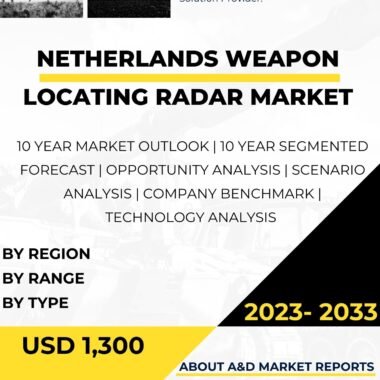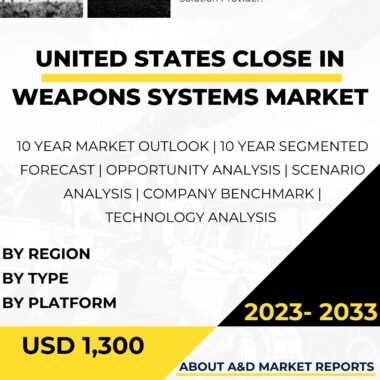Description
The close-in weapons systems (CIWS) market in Spain is an integral part of the country’s defense industry, providing critical protection against airborne and surface threats. CIWS are highly advanced and automated weapons systems designed to engage and neutralize incoming missiles, aircraft, and small boats at close ranges. Spain’s geographical location, as a Mediterranean country with a long coastline, underscores the importance of robust CIWS capabilities to defend against potential threats and ensure national security.
The Spanish Navy, in particular, relies on close-in weapons systems to protect its fleet and maritime assets. CIWS are installed on various naval vessels, including frigates, destroyers, aircraft carriers, and amphibious assault ships. These systems provide an essential layer of defense against fast-attack craft, anti-ship missiles, and other asymmetric threats that may pose risks in littoral or open-ocean environments.
The adoption and modernization of CIWS technologies in Spain are driven by several factors. The evolving nature of maritime threats, including the proliferation of anti-ship missiles and unmanned aerial vehicles (UAVs), necessitates continuous upgrades to CIWS capabilities. Advanced CIWS systems offer improved detection, tracking, and engagement capabilities, providing the Spanish Navy with enhanced protection against a wider range of threats.
The Spanish defense industry plays a critical role in meeting the country’s CIWS requirements. Domestic companies such as Indra Sistemas have been involved in the development and integration of CIWS solutions for the Spanish Navy. These companies leverage their expertise in radar, sensors, and command and control systems to deliver state-of-the-art CIWS technologies tailored to Spain’s defense needs.
International collaboration is also vital in Spain’s CIWS market. Many CIWS systems are developed and manufactured by international companies with proven track records in naval defense technologies. Spain collaborates with these suppliers to acquire and integrate CIWS systems into its naval platforms. Joint ventures and technology transfer agreements enable the Spanish defense industry to contribute to the development of CIWS technologies while benefiting from international expertise.
Technological advancements in CIWS systems include improvements in sensor capabilities, fire control radars, and advanced ammunition options. These upgrades enable CIWS systems to engage multiple threats simultaneously, increasing the effectiveness of the defense envelope. The integration of these advanced systems with the Spanish Navy’s overall command and control network further enhances situational awareness and rapid response capabilities.
The Spanish Navy places great importance on the training and readiness of its personnel in operating CIWS systems. Comprehensive training programs and regular drills are conducted to ensure that sailors are proficient in using CIWS effectively during critical situations. These exercises also enable the Spanish Navy to test the systems’ readiness and identify areas for improvement.
Budgetary considerations are a significant factor in the CIWS market. Spain’s defense spending is subject to economic conditions and government priorities, which can impact the acquisition and modernization of CIWS technologies. Balancing the allocation of resources between acquiring new CIWS systems and maintaining existing capabilities requires careful planning and prioritization.
Additionally, the Spanish Navy’s broader modernization efforts influence CIWS procurement decisions. The Navy seeks to enhance its overall combat capabilities, which may involve upgrades to other critical naval systems and platforms. Aligning CIWS acquisitions with these broader modernization efforts ensures a comprehensive and integrated approach to maritime defense.
Moreover, international arms control agreements play a role in Spain’s CIWS market. The Spanish government is committed to complying with international regulations and security standards to prevent the proliferation of advanced naval defense technologies.
The CIWS market in Spain also faces challenges related to the changing nature of maritime threats. The emergence of new technologies, such as swarm tactics and hypersonic missiles, poses challenges to traditional CIWS systems. Anticipating and countering these threats requires continuous research and development to keep pace with the evolving landscape of naval warfare.
In conclusion, the close-in weapons systems market in Spain is a crucial component of the country’s defense industry. CIWS systems are essential for providing critical protection to naval vessels and maritime assets against airborne and surface threats. The adoption and modernization of CIWS technologies are driven by the evolving nature of maritime threats and the need for enhanced protection capabilities. Collaboration between domestic companies and international suppliers enables Spain to access advanced CIWS technologies while contributing to their development. Technological advancements, training and readiness programs, budgetary considerations, and compliance with international arms control agreements are all factors influencing Spain’s CIWS market. As the Spanish Navy continues to prioritize its modernization efforts, CIWS systems will remain a key focus in enhancing its maritime defense capabilities and safeguarding national security in the face of evolving threats.




